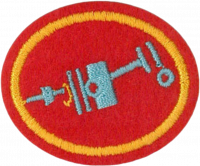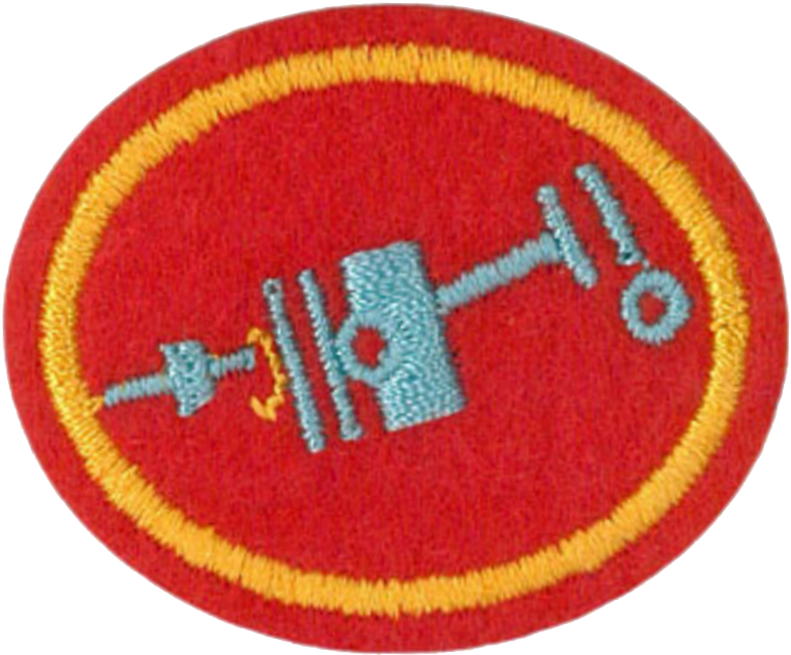Especialidades JA/Motores pequeños/Respuestas
Nivel de destreza
2
Año
1975
Version
12.11.2025
Autoridad de aprobación
Asociación General
1
2
- Spark Plug: The spark plug produces an electrical spark igniting the air/fuel mixture as the piston reaches the top of the cylinder.
- Piston: The piston travels up and down inside the cylinder. Its downward motion is propelled by an explosion of air and fuel ignited by the spark plug.
- Rod: The rod connects the piston to the crankshaft.
- Crankshaft: The crankshaft converts the piston's up-and-down motion into rotary motion and transfers the engine's power to the outside of the engine.
- Cylinder: The cylinder is the space inside the engine block in which the piston moves. Combustion occurs at the top of the cylinder.
- Crankcase: The crankcase is the cavity in the engine block beneath the cylinder, and is where the crankshaft is. This is where fuel is drawn into the engine prior to being forced into the cylinder.
- Intake Port: The intake port is the passage-way between the crankcase and the cylinder.
- Intake Valve: The intake valve opens to allow the air/fuel/oil mixture to enter the crankcase during the piston's up-stroke, and closes to prevent its escape, and cause it to pressurize during the piston's down-stroke.
- Exhaust Port: The exhaust port is a hole in the cylinder wall through which the burnt fuel (exhaust) is expelled.
- Flywheel: The flywheel is a mass attached to the crankshaft. It preserves the engine's momentum, keeping the crankshaft turning between the explosions in the combustion chamber. It also has a magnet in one side, which passes by the magneto, generating the electricity to fire the spark plug.
- Magneto: The magneto sits next to the flywheel, and has a coil that acts like a generator when the magnet in the flywheel passes it. In older engines, the power from the magneto coil is switched by points, to control the timing of the spark. On newer engines, it uses electronics to control the spark, by sensing where the magnet on the flywheel is.
- Fuel Filter: The fuel filter captures dirt in the fuel, preventing it from entering the carburetor.
- Carburetor: The carburetor is the device that mixes the fuel and air together prior to its being transferred into the engine.
3
- Gasoline is the most common fuel for small engines, especially those found on lawnmowers, snow blowers, tillers, and other garden equipment.
- Gasoline/oil mixture is used in two stroke engines. The ratio of gas to oil is usually in the range of 16:1 to 50:1. Two stroke engines are often found on smaller items such as chain saws and weed trimmers.
- Diesel fuel is sometimes used in larger "small" engines, such as those found on riding mowers, small tractors, or electric generators.
- Nitromethane is used for very small engines, such as those that power Radio Controlled model airplanes.
4
5
Material for this section was adapted from the Wikipedia article on Ignition Systems
Glow plug ignition
Glow plug ignition is used on some kinds of simple engines, such as those commonly used for model aircraft. A glow plug is a coil of wire (made from nichrome normally) that will glow red hot when an electric current is passed through it. This ignites the fuel on contact, once the temperature of the fuel is already raised due to compression. The coil is electrically activated for engine starting, but once running, the coil will retain sufficient residual heat on each stroke due to the heat generated on the previous stroke. Glow plugs are also used to aid starting of diesel engines.
6
Gasoline is extremely flammable and dangerous to work with. It is also a carcinogen (cancer-causing agent), so prolonged contact with it should be avoided. It can also damage plastic parts. Gasoline left on parts can burst into flame at the slightest provocation, causing an engine fire. It also has many additives, some of which stay on the part after you clean it. They also soak into your bloodstream.
7
Mineral Spirits are often used for cleaning parts. Soaking parts in mineral spriits removes oil and grease without the need for scrubbing. Once the parts are removed from the bath, the mineral spirits quickly evaporate.
8
- Splash: In a splash lubrication system, dippers on the crankshaft are repeatedly submerged and lifted out of the oil in the oil pan. This happens as the crankshaft turns. When the dippers emerge from the oil bath, oil is splashed all about the inside of the chamber where it finds its way to the pistons, rods, and other moving parts. Channels are milled in the crankshaft to direct oil flow from the dippers to the bearings in the crankshaft, as it is vital that these receive plenty of lubrication.
- Pressurized: In a Pressurized lubrication system, an oil pump sucks oil from the oil pan and forces it through a filter and then on through a system of passageways drilled into various parts of the engine. These passageways are called galleries. The galleries open to spurt the oil onto critical components such as the bearings. Galleries are also drilled from the main block and from there into the crankshaft's main bearing. This connects to another gallery drilled into the crankshaft itself. The crankshaft gallery supplies oil to the connecting rod bearings.
- Combination Splash/Pressure: As the name suggests, a Combination Splash/Pressure lubrication system is a combination of the two systems described above. The connection between the rod and the piston, as well as the cylinder walls, are lubricated using the splash method. The main crankshaft bearings, as well as the camshaft, rocker arms, Etc. are lubricated by the pressurized system.
- Dry Sump: In a Dry Sump lubrication system, there is no oil in the oil pan. It is all stored in a pressurized reservoir, and then fed to the engine by the pump. Galleries are drilled in the crankshaft just as in the Pressurized system. But these galleries are also connected to galleries drilled in the connecting rod, and then through the pistons themselves. Oil is squeezed through these galleries where it spills out onto the cylinder wall.
Reference: Integrated Publishing
9
Remember the acronym FAST - Fuel, Air, Spark, and Timing.
- Fuel: Make sure fuel is getting into the combustion chamber. The most obvious thing is to make sure the engine is not out of gas. Then check the fuel lines, making sure they are in good shape and actually connected to what they should be connected to. If the engine is flooded (that is, it has too much fuel in the carburetor), let it sit for a while, and then try starting it again. If the engine has a fuel pump, make sure it's operating. Check that the filter is not clogged. A very common problem with small engines, especially after they have been sitting for a while, is for the carburetor to get clogged, or have the diaphragms get old and stiff. A normal carb is not very difficult to dissemble and clean, and rebuild kits can be obtained for a few dollars and will often solve the problem if you are still having problems after you check everything else. If all of these check out, move on to the next stage in the acronym, which is air.
- Air: Make sure the choke is adjusted properly. On an engine with a manual choke, close the choke all the way and open up the throttle. Then try to start it. If it doesn't start after a couple of pulls, open the choke halfway and try again. When the engine starts, open the choke over the next few seconds until the engine runs smoothly. If it still won't start, check that the air filter is not clogged.
- Spark: Check that you have spark, and that it is a good strong blue spark. You can use a spark tester, unscrew the sparkplug and hold the outer threaded part against the metal of the engine as you crank the engine and watch for a spark, or just hold the end of the spark plug wire 1/8" to 1/4" inch away from the metal of the engine as you crank the engine. Be careful not to touch the metal tip! The shock will really hurt, and it could cause serious injury, especially if you have a pacemaker. If it is an older style engine with points, you should check them. After a while, they can get dirty or corroded, or just wear away. They are often under the flywheel. Electronic ignition engines can have the module burn out. Or you could have a loose wire somewhere, or the kill switch could be shorted.
- Timing: On small engines, you normally can't adjust the timing, but that doesn't mean it can't be wrong! It is common on certain engines (Briggs and Stratton for instance) for the key holding the flywheel to the shaft to shear, (they are designed to do this to protect other parts of the engine, kind of like a fuse), and when it shears, the flywheel turns on the shaft. so you will still get a spark, but it won't be at the right time. so you should check the flywheel is in the correct position on the crankshaft. Engines that use a point style ignition system sometimes have an adjustment on the points, which are usually under the flywheel.
10
Consult with a Qualified Person for this part! Don't just tear into the family lawnmower, and hope you can get it all back together. You are likely to end up with "extra" parts left over when you are done! (which is not a good thing)
11
A toothbrush can be a good tool to clean spark plugs. (Don't use it to brush your teeth afterwards though!) You also need to use a spark plug gap gage, or a feeler gage to set the spark plug gap according to the engine specs. When cleaning them, you just need to get all the carbon and soot buildup off. These days, sparkplugs are usually just replaced if they are full of crud.


